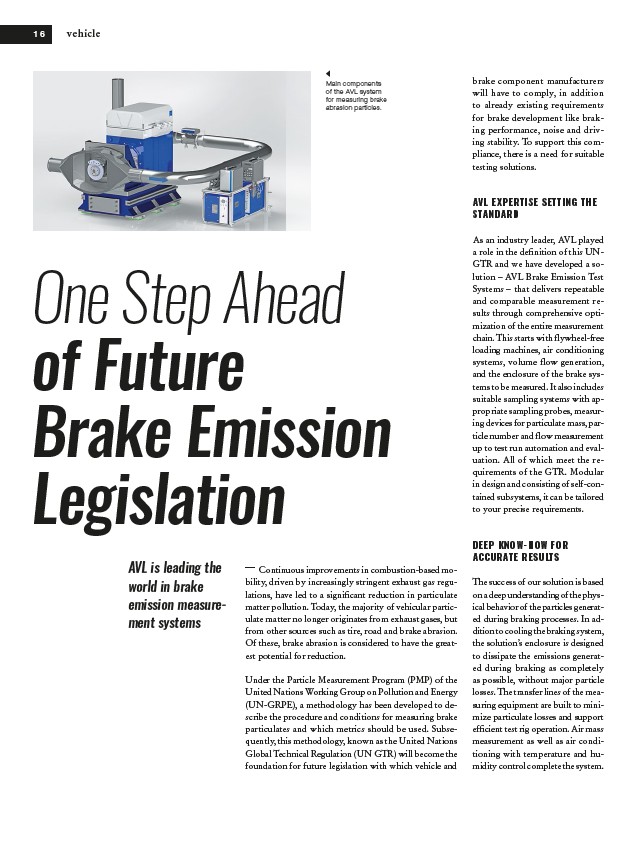
1 6 vehicle
One Step Ahead
of Future
Brake Emission
Legislation
Continuous improvements in combustion-based mobility,
driven by increasingly stringent exhaust gas regulations,
have led to a significant reduction in particulate
matter pollution. Today, the majority of vehicular particulate
matter no longer originates from exhaust gases, but
from other sources such as tire, road and brake abrasion.
Of these, brake abrasion is considered to have the greatest
potential for reduction.
Under the Particle Measurement Program (PMP) of the
United Nations Working Group on Pollution and Energy
(UN-GRPE), a methodology has been developed to describe
the procedure and conditions for measuring brake
particulates and which metrics should be used. Subsequently,
this methodology, known as the United Nations
Global Technical Regulation (UN GTR) will become the
foundation for future legislation with which vehicle and
AVL is leading the
world in brake
emission measurement
systems
brake component manufacturers
will have to comply, in addition
to already existing requirements
for brake development like braking
performance, noise and driving
stability. To support this compliance,
there is a need for suitable
testing solutions.
AVL EXPERTISE SETTING THE
STANDARD
As an industry leader, AVL played
a role in the definition of this UNGTR
and we have developed a solution
– AVL Brake Emission Test
Systems – that delivers repeatable
and comparable measurement results
through comprehensive optimization
of the entire measurement
chain. This starts with flywheel-free
loading machines, air conditioning
systems, volume flow generation,
and the enclosure of the brake systems
to be measured. It also includes
suitable sampling systems with appropriate
sampling probes, measuring
devices for particulate mass, particle
number and flow measurement
up to test run automation and evaluation.
All of which meet the requirements
of the GTR. Modular
in design and consisting of self-contained
subsystems, it can be tailored
to your precise requirements.
DEEP KNOW-HOW FOR
ACCURATE RESULTS
The success of our solution is based
on a deep understanding of the physical
behavior of the particles generated
during braking processes. In addition
to cooling the braking system,
the solution’s enclosure is designed
to dissipate the emissions generated
during braking as completely
as possible, without major particle
losses. The transfer lines of the measuring
equipment are built to minimize
particulate losses and support
efficient test rig operation. Air mass
measurement as well as air conditioning
with temperature and humidity
control complete the system.
Main components
of the AVL system
for measuring brake
abrasion particles.